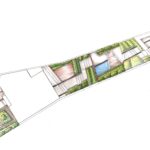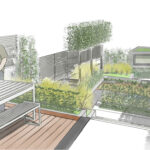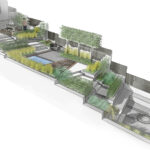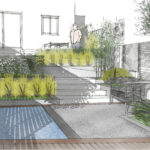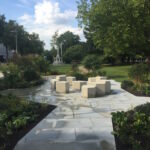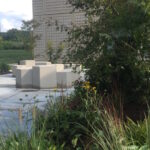Rachel Reynolds
Graduating from LCGD as Top Student 2016, I combine a strong spatial awareness with a deep sensitivity to historical and environmental factors to produce contextual and sustainable designs. Since graduating I have worked on both commercial and domestic projects, completing a Memorial Garden for Dulwich College, a number of urban gardens and have assisted Nigel Dunnett with the detailed design and project management of his 2017 Greening Grey Britain RHS Chelsea show garden.
Prior to entering the garden design profession, I worked as a multi disciplinary 3D designer & maker. My background includes project management for Ron Arad, a production range of concrete street furniture with Furnitubes, Participatory Public Art projects for Brighton City Council and many years as a self employed designer of bespoke, exterior furniture.
Designs for a steeply sloping, wedge of a garden attached to a 1930s suburban semi. The client wanted a contemporary feel, with deep planting areas and no lawn. Also on the wish list was a children’s den and trampoline, a dining terrace, a fire pit and a water feature or pond. The design solution to fit all into the small space to run integrated planting beds alongside the steps, so the level changes between the three terraces become important elements of the garden. The desired trampoline and den were built to sit onto top of the lower terrace and hence when the children have grown they can be removed to reveal the evening chill out zone, complete with fire pit.
A Memorial Garden within the grounds of Dulwich College, situated alongside a Grimshaw designed Laboratory building. The design of the garden celebrates the relationship between the Sciences and the Arts and is an exploration of Voronoi tessellation, which can be thought of as a geometrical tool to understand the physical constraints binding the organisation of biological tissues, natural structures and geological forms (such as honeycombs, the giants causeway and the packing structure of corn). The Memorial Garden is a physical representation of how human research is allowing us to understand these innate, natural geometric rules.
The Memorial Garden’s yorkstone paving pulls away from the formal, rectangular layout of the existing paving, disintegrating into a series of irregular convex polygons, closely reflecting the tensions within natural fragmentation patterns, from these tessellating polygons irregular extrusions rise up to form seating.
The garden integrates the new science block into the heritage site and also links the contemporary planting with the original Milner garden and wider site. The plants and trees have be chosen to reflect both the terracotta cladding and the detailing of the nearby Barry building.

